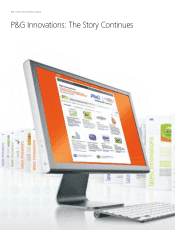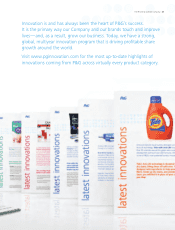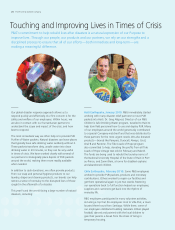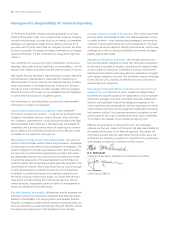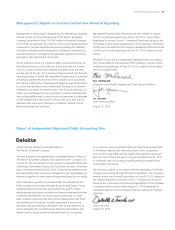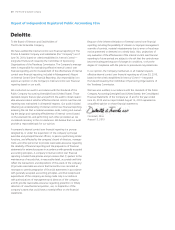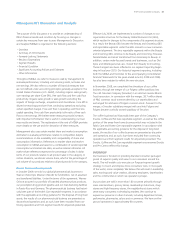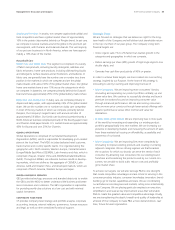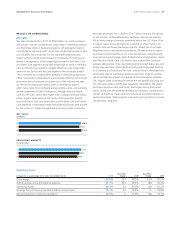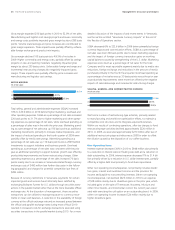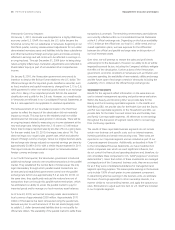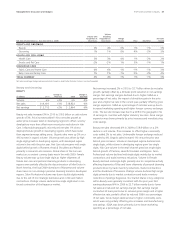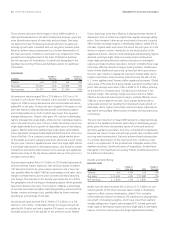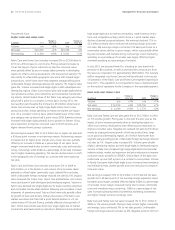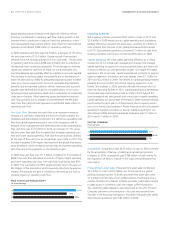Proctor and Gamble 2010 Annual Report Download - page 36
Download and view the complete annual report
Please find page 36 of the 2010 Proctor and Gamble annual report below. You can navigate through the pages in the report by either clicking on the pages listed below, or by using the keyword search tool below to find specific information within the annual report.34 The Procter & Gamble Company Management’s Discussion and Analysis
SUMMARY OF 2010 RESULTS
• Net sales increased 3% to $78.9billion.
– Organic sales increased 3%.
– Unit volume increased 4% versus the prior year, behind mid-
single-digit growth in developing regions and low single-digit
growth in developed regions.
• Net earnings decreased 5% to $12.7billion.
– Net earnings from continuing operations increased 2% to
$10.9billion behind sales growth and operating margin
expansion, partially offset by a higher effective tax rate.
– Operating margin expanded 30 basis points versus the prior
year due to higher gross margins, mostly offset by an increase
in selling, general and administrative expenses (SG&A) as a
percentage of net sales.
– Net earnings from discontinued operations declined $1.0billion
to $1.8billion due to the loss of contribution from the divested
pharmaceuticals and coffee businesses and lower current period
gains on the sale of discontinued operations.
• Diluted net earnings per share declined 4% to $4.11.
– Diluted net earnings per share from continuing operations
increased 4% to $3.53.
– Diluted net earnings per share from discontinued operations
declined 33% to $0.58.
– Core EPS grew 6% to $3.67.
• Cash flow from operating activities was $16.1billion.
– Free cash flow was $13.0billion.
– Free cash flow productivity was 102% and included a negative
23% impact resulting from the global pharmaceuticals
divestiture.
FORWARD-LOOKING STATEMENTS
We discuss expectations regarding future performance, events and
outcomes, such as our business outlook and objectives, in annual
and quarterly reports, press releases and other written and oral
communications. All such statements, except for historical and present
factual information, are “forward-looking statements,” and are based
on financial data and our business plans available only as of the
time the statements are made, which may become out-of-date or
incomplete. We assume no obligation to update any forward-looking
statements as a result of new information, future events or other
factors. Forward-looking statements are inherently uncertain and
investors must recognize that events could be significantly different
from our expectations. For more information on risks that could
impact our results, refer to Item 1A Risk Factors in our most recent
10-Q, 10-K and 8-K filings.
Ability to Achieve Business Plans. We are a consumer products
company and rely on continued demand for our brands and products.
To achieve business goals, we must develop and sell products that
appeal to consumers and retail trade customers. Our continued success
is dependent on leading-edge innovation with respect to both products
and operations and on the continued positive reputations of our
brands. This means we must be able to obtain patents and respond
to technological advances and patents granted to competition. Our
success is also dependent on effective sales, advertising and market-
ing programs in an increasingly fragmented media environment.
Our ability to innovate and execute in these areas will determine the
extent to which we are able to grow existing sales and volume profit-
ably, especially with respect to the product categories and geographic
markets (including developing markets) in which we have chosen to
focus. We operate in an increasingly volatile economic environment
with high levels of competitive activity. To address these challenges,
we must respond to competitive factors, including pricing, promo-
tional incentives, trade terms and product initiatives. We must manage
each of these factors, as well as maintain mutually beneficial relation-
ships with our key customers, in order to effectively compete and
achieve our business plans. As a company that manages a portfolio of
consumer brands, our ongoing business model involves a certain level
of ongoing acquisition and divestiture activities. We must be able to
successfully manage the impacts of these activities, while at the same
time delivering against base business objectives. Our success will also
depend on our ability to maintain key information technology systems.
Cost Pressures. Our costs are subject to fluctuations, particularly due
to changes in commodity prices, raw materials, cost of labor, foreign
exchange and interest rates. Therefore, our success is dependent, in
part, on our continued ability to manage these fluctuations through
pricing actions, cost savings projects, sourcing decisions and certain
hedging transactions. We also must manage our debt and currency
exposure, especially in certain countries with currency exchange
controls, such as Venezuela, China and India. We need to maintain
key manufacturing and supply arrangements, including sole supplier
and sole manufacturing plant arrangements. We must implement,
achieve and sustain cost improvement plans, including our outsourc-
ing projects and those related to general overhead and workforce
optimization. Successfully managing these changes, including identi-
fying, developing and retaining key employees, is critical to our success.
Global Economic Conditions. Economic changes, terrorist activity
and political unrest may result in business interruption, inflation,
deflation or decreased demand for our products. Our success will
depend, in part, on our ability to manage continued global political
and/or economic uncertainty, especially in our significant geographic
markets, as well as any political or economic disruption due to terror-
ist and other hostile activities.
Regulatory Environment. Changes in laws, regulations and the related
interpretations and enforcement actions may alter the environment
in which we do business. This includes changes in environmental,
competitive and product-related laws, as well as changes in account-
ing standards, taxation requirements and enforcement penalties. Our
ability to manage regulatory, tax and legal matters (including product
liability, patent, intellectual property, competition law matters and tax
policy) and to resolve pending legal matters within current estimates
may impact our results.


